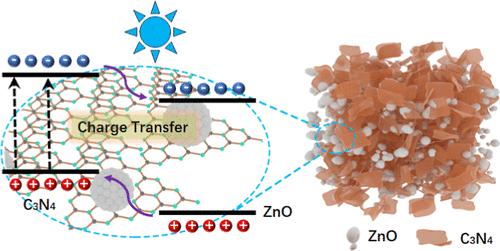通过电荷转移构建具有光催化活性的 ZnO/C3N4 复合材料
IF 5.5
2区 材料科学
Q2 MATERIALS SCIENCE, MULTIDISCIPLINARY
引用次数: 0
摘要
基于 ZnO/C3N4 复合材料的光催化剂可以利用 ZnO 的高载流子迁移率和 C3N4 的可见光吸收特性。通过这两种材料的协同效应提高光催化性能的关键在于有效的电荷转移。本研究采用超声波分散和水热法相结合的方法制备了 ZnO/C3N4 复合材料。这种复合材料的结构由 C3N4 薄层和尺寸为几十纳米的 ZnO 纳米颗粒组成。理论计算结合光致发光光谱技术证实,电荷转移发生在 ZnO/C3N4 交错间隙异质结中,从而减少了光生载流子的重组,提高了光催化效率。通过空间和时间分辨荧光成像测量,观察了 ZnO/C3N4 复合材料不同区域电荷转移效率的变化。污染物的光催化降解表明,C3N4 的最佳用量为 8%。在太阳模拟器下,100 分钟内污染物的降解效率达到了惊人的 88%,最快降解速率为 0.022 min-1。这种高效率与 ZnO 和 C3N4 的紧密结合及其有效的电荷转移率密切相关。此外,ZnO/C3N4 复合材料还具有稳定的光催化性能。本文章由计算机程序翻译,如有差异,请以英文原文为准。

Construction of ZnO/C3N4 Composite for Photocatalytic Activity through Charge Transfer
The photocatalyst based on the ZnO/C3N4 composite can harness the high carrier mobility of ZnO along with the visible light absorption characteristics of C3N4. The key to enhance photocatalytic performance through the synergistic effect of these two materials lies in the effective charge transfer. In this work, a combination of ultrasonic dispersion and hydrothermal method was employed to prepare a ZnO/C3N4 composite. The structure of this composite consists of C3N4 thin layers covering ZnO nanoparticles with a size of several tens of nanometers. Theoretical calculations combined with photoluminescence spectroscopy techniques confirmed that charge transfer occurs in ZnO/C3N4 staggered gap heterojunction, which reduces the recombination of photogenerated carriers and enhances the photocatalytic efficiency. The variations of charge-transfer efficiency in different regions of the ZnO/C3N4 composite were observed by spatially and temporally resolved fluorescence imaging measurements. The photocatalytic degradation of pollutants revealed that the optimal amount of C3N4 is 8%. It achieved an impressive 88% degradation efficiency of the pollutant within 100 min and the fastest degradation rate of 0.022 min–1 under the solar simulator. This high efficiency is closely associated with the tight integration between ZnO and C3N4 and their effective charge-transfer rates. Furthermore, the ZnO/C3N4 composite demonstrated a stable photocatalytic performance.
求助全文
通过发布文献求助,成功后即可免费获取论文全文。
去求助
来源期刊

ACS Applied Nano Materials
Multiple-
CiteScore
8.30
自引率
3.40%
发文量
1601
期刊介绍:
ACS Applied Nano Materials is an interdisciplinary journal publishing original research covering all aspects of engineering, chemistry, physics and biology relevant to applications of nanomaterials. The journal is devoted to reports of new and original experimental and theoretical research of an applied nature that integrate knowledge in the areas of materials, engineering, physics, bioscience, and chemistry into important applications of nanomaterials.
 求助内容:
求助内容: 应助结果提醒方式:
应助结果提醒方式:


